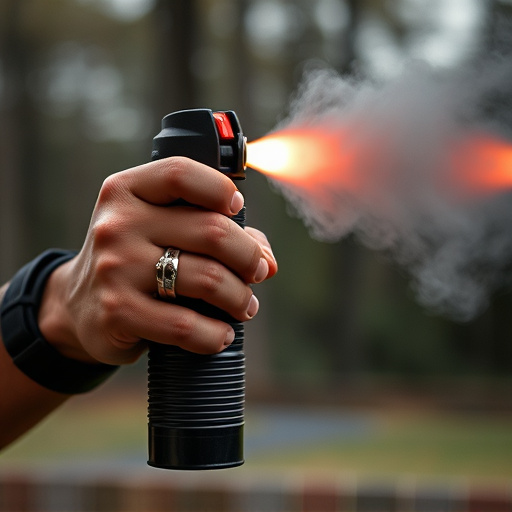TL;DR:
Proper pepper spray maintenance and storage are critical for law enforcement effectiveness and safety. This involves regular cleaning, calibration, and storage in cool, dry conditions to preserve potency. Strict inventory management, including inspections and locked storage, prevents loss or misuse. Training on handling, deployment, decontamination, and equipment use ensures safe and reliable operation during tactical operations and crowd control.
“Pepper spray, a versatile law enforcement tool, offers a non-lethal means of incapacitation. This comprehensive guide delves into the intricacies of pepper spray weapons, focusing on maintenance, storage, and safety protocols. Understanding the composition and effectiveness of this potent agent is key to ensuring optimal performance. Learn best practices for regular upkeep, secure storage methods to prevent misuse, and critical safety measures during deployment and subsequent aftercare. Maximize your agency’s readiness with informed strategies regarding pepper spray management.”
- Understanding Pepper Spray Composition and Effectiveness
- Maintenance Procedures for Optimal Performance
- Secure Storage Practices to Prevent Misuse
- Safety Protocols During Deployment and Aftercare
Understanding Pepper Spray Composition and Effectiveness
Pepper spray, a potent chemical agent, is designed to incapacitate individuals temporarily through irritation and pain. Understanding its composition is crucial for law enforcement officers to ensure effectiveness. The primary active ingredient in pepper spray is capsaicin, derived from chili peppers. This compound stimulates nerve endings, leading to a burning sensation and temporary blindness. The spray also contains various other chemicals like hydroxyethyl cellulose, which enhances its adhesive properties, ensuring the capsaicin stays on the target’s skin and eyes for prolonged discomfort.
Proper maintenance and storage of pepper spray are vital to guarantee its longevity and optimal performance. Regular cleaning and calibration ensure the device functions correctly when needed. Storage should be in a cool, dry place away from direct sunlight and heat sources. Additionally, keeping it out of reach of unauthorized individuals is critical. Law enforcement agencies must also implement strict protocols for inventory management, including regular inspections to prevent loss or damage, ensuring the spray remains effective when required for crowd control or tactical operations.
Maintenance Procedures for Optimal Performance
Proper pepper spray maintenance is crucial for ensuring optimal performance and longevity of the device. Law enforcement agencies should establish clear guidelines for regular cleaning, inspection, and testing routines. This includes removing any debris or buildup inside the canister and regularly checking the integrity of the nozzle and seals to prevent leaks. Storage practices are equally important; storing pepper spray in a cool, dry place away from direct sunlight will maintain its potency and effectiveness.
Additionally, regular training sessions for officers on how to properly deploy and handle the spray are essential. This includes familiarization with the specific type of pepper spray used, as different formulations may require unique application techniques. By combining diligent maintenance practices with adequate training, law enforcement can maximize the reliability and impact of their pepper spray equipment during critical situations.
Secure Storage Practices to Prevent Misuse
Law enforcement agencies must prioritize proper pepper spray maintenance and storage to prevent misuse and ensure officer safety. Secure storage practices include keeping pepper spray out of reach and sight, utilizing locked cabinets or containers, and implementing strict access controls. Regular inventory checks are crucial to track stock levels and detect any unauthorized use or loss.
Furthermore, training officers on the proper handling, deployment, and decontamination procedures after use is essential. This includes teaching them to store pepper spray correctly between uses. By adhering to these practices, law enforcement can maximize the effectiveness of their pepper spray while minimizing risks associated with misuse or accidental exposure.
Safety Protocols During Deployment and Aftercare
Safety Protocols During Deployment:
When deploying pepper spray, law enforcement officers must adhere to strict safety protocols. This includes ensuring proper ventilation and minimizing the risk of cross-contamination by using specialized equipment and protective gear. Officers should also be trained in the correct application technique, aiming for the eyes and face to maximize effectiveness while minimizing harm to non-target areas. Regular practice sessions help maintain proficiency and promote safe usage.
Aftercare and Pepper Spray Maintenance:
After each use, proper decontamination procedures are crucial. This involves rinsing affected areas with water and cleaning personal protective equipment (PPE) to prevent residual pepper spray from causing prolonged discomfort or irritation. Regular maintenance of pepper spray devices is equally important, including periodic inspections, testing, and replacing components as needed. Proper storage practices, such as keeping the device in a secure, labeled container out of reach of unauthorized personnel, ensure its longevity and readiness for future use.
Pepper spray, a powerful law enforcement tool, requires meticulous maintenance and secure storage practices for optimal effectiveness and safety. By understanding its composition, implementing proper deployment protocols, and adhering to strict aftercare measures, officers can ensure this weapon remains a reliable and responsible asset in their arsenal. Regular Pepper Spray Maintenance and Storage practices are key to maximizing its performance while minimizing the risk of misuse.
